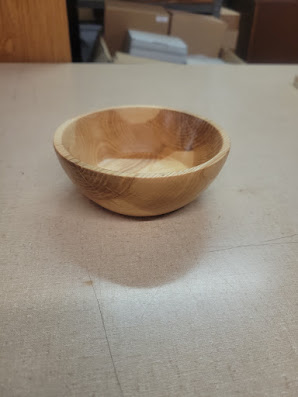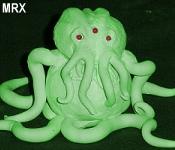Monday, February 3, 2025
Vine Knife
Monday, January 27, 2025
Ash Bowl
A few years ago, my daughter asked me to make her a fruit bowl. I'm still working on that one. I kinda suck at turning bowls, and as that project was not going so well, I decided I needed some practice before continuing. So, I dug out some old bowl blanks that I rough cut from the very first batch of logs that I ever sourced off the internet. These ash bowl blanks have been sitting around drying for about eight years. I ended up giving this bowl to my daughter to tide her over until her nice cherry fruit bowl gets finished.
Monday, January 20, 2025
Planchettes v2.0
This is another post of a small batch of items that was made for sale at my store before it closed. I was hoping to create a line of planchettes that I could cut out completely on the laser cutter, and that would require less hand finishing than the solid wooden planchettes that I had previously made. Unfortunately, they still required more hand finishing than I had hoped, and I was unhappy with the quality of the final product. I only made one batch of them, and while they did sell, I considered this a failed product experiment.
Monday, November 25, 2024
Light My Fire
One of the projects I made to sell at the store, shortly before it closed, was a line of candles with a variety of artwork on them. The candles themselves are not ones I made. I bought them at a discount store, mostly with the intention of melting them down, as they cost less than an equivalent weight of raw wax at the time. For many years I had the idea of making custom pillar candles with some sort of decorative applique, but I was envisioning more of a 3d applique. However, after several years of failing to come up with anything on that front, I decided to try just painting a design on some pillar candles.
The first one of these I made was done with a vinyl stencil, cut on my new Silhouette Cameo 4, and then painted, but I only made one of those. It was a time consuming and tedious process. Then I thought to try a water slide decal, printed on a laser printer. This was much, much faster and also allowed for a much higher level of detail in the image. I ended up making 50 or more of these in about a dozen different designs. I thought they turned out rather well. This isn't much of a blog worthy project, but it was meant to be a fast turnaround high margin product, not art.
Monday, November 18, 2024
Get Your Strap On
I just wrapped up construction of a project that has been on my to-do list for several years: guitar straps. You see, about fifteen years ago, I did a re-build of the old lighting rig for Rogue Cthulhu. I build log of that re-build to post here has also been on my to-do list for several years. Anyway, part of that re-build included using a winch to raise the new light rig. That winch used nylon webbing (seat belt material) instead of the usual rope on the winch. I sourced a fair bit of grey and also black 2" webbing for that project and had quite a bit left over. My immediate thought was, "let's use it to make guitar straps." That thought ruminated in my mind for the next fifteen years, until last night.
Over the past two or so years, I've been piecing together the other parts I'd need to make the guitar strap project; buckles, leather... Well, that's pretty much it, buckles and leather, and I already had the leather. But in my defense, I did have a difficult time finding buckles that I thought were perfect for the job, and also, I didn't look very hard.
The leather I used is a thin soft calf skin like black leather (not sure of its origin) with a textured pattern on one side. I found this leather at a discount store many many years ago. It is far too thin and weak to be used for the strap ends, so of course, that's what I used it for. To make it work, I doubled up the leather, giving me the textured pattern surface on both sides, and also sandwiched 10 oz. black cotton canvas between the layers. These I married with spray adhesive, and would later stitch the edges for reinforcement. I cut out the strap ends with the help of a template I made in Inkscape, using an existing guitar strap from my collection as a guide.
Once all the pieces and the stars aligned, All that was left was to dig out the sewing machine and assemble the straps. It was pretty evident that I hadn't used my sewing machine in quite a while. My first attempt yielded pretty horrible results. After switching to grey thread, like a normal person would, I ripped out and re-sewed that zig-zag stitch about a dozen times before I was satisfied with the results (read as: too frustrated to continue).
After adding the buckles and stitching the ends, I cut the strap button holes with a hole punch and a craft knife. That's it. It took about an afternoon to make three of them. Probably would have gone a lot faster if my sewing wasn't so bad.
Monday, November 11, 2024
Who You Gonna' Call?
Here we have a small wood end table, painted black that I picked up from a discount store for about $20. Like many other such items that I buy for the store with the intention of modifying and reselling, it sat in the back room for several years untouched. Finally it got bumped up to the front of the line, mostly because it took up too much space and I needed it out of the back room.
As I was more interested in clearing it out of storage than I was with creating something wonderful, at first I copped out and just slapped a pentagram on it to try to sell it and get my money back out of it (and the space it was taking up in my workroom). I stenciled and painted a gold pentagram in the center and put it out on the floor to sell, but even then, it didn't look finished. It stayed on the sales floor for about a week before inspiration struck and I knew what I had to do to finish this piece. I needed to make it into an ouija board.
I had long intended to start making spirit boards to pair with my planchettes that I was making and which were selling decently well. But I never managed to find the time to do the layout work to get started onn the project. The only spirit board I had ever attempted ended up getting stalled at around the 70% complete mark back in 1993 (and still remains unfinished to this day). I measured the table top and the pentagram and went into my vector image software to create a layout for the spirit board top. Normally I would use masking tape or make a paper template and cut the stencil by hand for something like this, but this time, I decided to use my newest toy, the Silhouette Cameo 4 vinyl cutter. After laying out the image design in Inkscape, I broke it down into sections small enough to cut out on my vinyl cutter and used it to cut the mask. Once the mask was cut, the sections had to be properly positioned and transferred to the table top. The positioning was a bit tricky, but fortunately the vinyl masking is fairly forgiving. Then it was a fairly simple matter to paint and remove the stencil.
This is the first spirit board that I ever completed and one of the last items I made for the store before it closed.
Monday, November 4, 2024
I'm On Drugs!

Howdy kids. Well, I'm back, and I feel real good about myself. Just kidding, but I do feel a little better. How, you may ask? Through the wonders of modern chemistry! You see, after long reflection and the realization that I am likely now in the last decade or two of my life, I came to a decision. I decided that for once, I'd like to not feel miserable. So, after 50 years of avoiding it, I made the move to seek out professional help, and now I am moderately medicated. I've been taking meds and doing counseling for my mental health for the past year, and have seen some mild improvement. I'm not farting sunshine and pissing rainbows, but I do feel better and I'm starting to be a little more active again. It's more like being back to my usual level of misery that I'd endured for the last 30 years, instead of the debilitating nightmare that has been the past nine.
What does all this mean for you, you ask? You selfish bastards; Is that all you think about? Well, after my most recent medication adjustment, I'm finally starting to feel motivated again, and have actually spent the past few days in the workshop! Not making anything you'd want to see of course, just some new shelves for my kitchen, but considering that it's been more than two years since my last post (holy shit, it's been more than TWO YEARS since my last post!) that's got to be a good sign.
So, I'm reorganizing the kitchen, and looking to make some more storage space, and free up some counter space, and just generally improve the layout. Above is a little shelf I made to fit over the rear control panel on my stove. It will give me a little more space for holding seasonings and such, and will prevent things from falling off and ending up behind the stove.
This is a little shelf that spans between the refrigerator and the microwave stand. Again, more storage space. I've got too many pots and pans to fit in my cupboards any more. Odd, for someone who rarely cooks anything but canned chili, I know, but here we are.
Looking over my photo folders, There were actually a handful of items that I made for the store before it closed that never made it onto this blog, so I'm going to try to get some of those documented over the next few days. Hopefully by then, I'll be on to something more exciting. I'm hoping to make a few quick items to try to sell to some of the other local pagan shops before the holidays.
Here's to a considerably more productive and moderately less miserable final decade or two. Cheers.
Friday, June 10, 2022
Totally Cherry
It has been more than two years since I have made something- like, actually made something, not just modified or laser etched it, but actually crafted it with my hands from scratch. The Rogue Cthulhu dice boxes were probably the last thing I really made.
Not gonna lie, things have been rough. Rogue Cthulhu has been retired. My gaming days have come to an end. Book of Shadows, my store, has been shut down. The building was badly vandalized and it did not make economic sense to make the repairs needed to stay open. My mental health continues to struggle. I can go weeks without leaving the house or even getting dressed. So, at this stage, for me to make something is a major achievement. But, I sold a rune set on Etsy today, and I think that gave me a little spark of energy.
It's not quite finished yet, but it's close. This is a hand turned wand made from locally sourced cherry wood that I seasoned and milled myself. There is going to be a crystal point embedded into the tip (where the hole is), but other than that, it is done. I was a little surprised that the piece came together with little difficulty. This is probably the first time I have touched my lathe in three years. It isn't perfect, but considering how out of practice I am, it's pretty good.
I love this batch of wood. The color is very pleasing. Even the sapwood is nice. I've got quite a bit of it, so I expect I'll be doing a lot of projects in cherry in the future. Now that the store is closed, I'm going to have to focus more on online sales in order to have any income. My needs are small, but I've been bleeding money for the past two years, so it's either make internet sales, or get a straight job, and I'm a little too old and jaded for that!
I have a couple more wands that I started years ago, and got them to about this same point and never finished them. I think I'll try to make a couple more, and then add the tips to all of them at once and post them in a batch. I was just so excited to have accomplished something in the workshop that I had to post it, finished or not.
P.S. I'm not dead yet.
Wednesday, June 2, 2021
Rogue Cthulhu Dice Box
Just a few months before COVID shut down all gaming conventions all over the world, I regained control of Rogue Cthulhu, the gaming club I co-founded over 20 years ago. In those few months between Thanksgiving 2019 and when the world shut down in March 2020, I was hard at work trying to prepare for the next Rogue Cthulhu show at the Origins Gaming Convention. One of my areas of focus was to re-establish the prize table and point system that had been dismantled while I was away from the helm.
This is one of the prizes that I was working on at that time. Unfortunately, I don't have any pictures of its construction. It's a portable dice rolling box, with a side area for storing and transporting your gaming dice. The lid slides open like a pencil box top. The sides of the box are oak. The top and divider are sapele. The bottom is lined with bonded leather. The sides and top are all laser etched.
I'm not sure if or when Rogue Cthulhu might return to the gaming convention scene, but if it does, I will probably make more of these. I initially only made two, and since the future of the club is currently uncertain, I think I'm going to give these two away to some friends.














































